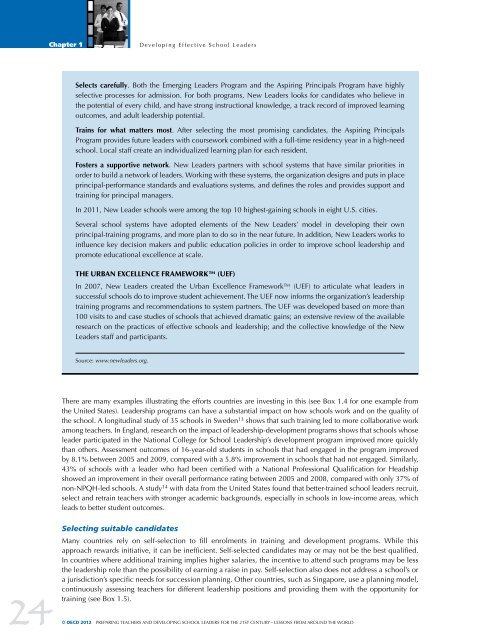Preparing Teachers and Developing School Leaders for the 21st Century
Preparing Teachers and Developing School Leaders for the 21st Century
Preparing Teachers and Developing School Leaders for the 21st Century
You also want an ePaper? Increase the reach of your titles
YUMPU automatically turns print PDFs into web optimized ePapers that Google loves.
24 ©<br />
Chapter 1<br />
developing effective school leaders<br />
Selects carefully. Both <strong>the</strong> emerging leaders Program <strong>and</strong> <strong>the</strong> aspiring Principals Program have highly<br />
selective processes <strong>for</strong> admission. <strong>for</strong> both programs, new leaders looks <strong>for</strong> c<strong>and</strong>idates who believe in<br />
<strong>the</strong> potential of every child, <strong>and</strong> have strong instructional knowledge, a track record of improved learning<br />
outcomes, <strong>and</strong> adult leadership potential.<br />
Trains <strong>for</strong> what matters most. after selecting <strong>the</strong> most promising c<strong>and</strong>idates, <strong>the</strong> aspiring Principals<br />
Program provides future leaders with coursework combined with a full-time residency year in a high-need<br />
school. local staff create an individualized learning plan <strong>for</strong> each resident.<br />
Fosters a supportive network. new leaders partners with school systems that have similar priorities in<br />
order to build a network of leaders. Working with <strong>the</strong>se systems, <strong>the</strong> organization designs <strong>and</strong> puts in place<br />
principal-per<strong>for</strong>mance st<strong>and</strong>ards <strong>and</strong> evaluations systems, <strong>and</strong> defines <strong>the</strong> roles <strong>and</strong> provides support <strong>and</strong><br />
training <strong>for</strong> principal managers.<br />
in 2011, new leader schools were among <strong>the</strong> top 10 highest-gaining schools in eight u.s. cities.<br />
Several school systems have adopted elements of <strong>the</strong> New <strong>Leaders</strong>’ model in developing <strong>the</strong>ir own<br />
principal-training programs, <strong>and</strong> more plan to do so in <strong>the</strong> near future. in addition, new leaders works to<br />
influence key decision makers <strong>and</strong> public education policies in order to improve school leadership <strong>and</strong><br />
promote educational excellence at scale.<br />
THE UrBAN ExCELLENCE FrAMEworK (UEF)<br />
in 2007, new leaders created <strong>the</strong> urban excellence framework (uef) to articulate what leaders in<br />
successful schools do to improve student achievement. The UEF now in<strong>for</strong>ms <strong>the</strong> organization’s leadership<br />
training programs <strong>and</strong> recommendations to system partners. <strong>the</strong> uef was developed based on more than<br />
100 visits to <strong>and</strong> case studies of schools that achieved dramatic gains; an extensive review of <strong>the</strong> available<br />
research on <strong>the</strong> practices of effective schools <strong>and</strong> leadership; <strong>and</strong> <strong>the</strong> collective knowledge of <strong>the</strong> new<br />
leaders staff <strong>and</strong> participants.<br />
source: www.newleaders.org.<br />
<strong>the</strong>re are many examples illustrating <strong>the</strong> ef<strong>for</strong>ts countries are investing in this (see Box 1.4 <strong>for</strong> one example from<br />
<strong>the</strong> united states). leadership programs can have a substantial impact on how schools work <strong>and</strong> on <strong>the</strong> quality of<br />
<strong>the</strong> school. a longitudinal study of 35 schools in sweden 13 shows that such training led to more collaborative work<br />
among teachers. in engl<strong>and</strong>, research on <strong>the</strong> impact of leadership-development programs shows that schools whose<br />
leader participated in <strong>the</strong> National College <strong>for</strong> <strong>School</strong> <strong>Leaders</strong>hip’s development program improved more quickly<br />
than o<strong>the</strong>rs. assessment outcomes of 16-year-old students in schools that had engaged in <strong>the</strong> program improved<br />
by 8.1% between 2005 <strong>and</strong> 2009, compared with a 5.8% improvement in schools that had not engaged. similarly,<br />
43% of schools with a leader who had been certified with a national Professional Qualification <strong>for</strong> headship<br />
showed an improvement in <strong>the</strong>ir overall per<strong>for</strong>mance rating between 2005 <strong>and</strong> 2008, compared with only 37% of<br />
non-nPQh-led schools. a study 14 with data from <strong>the</strong> united states found that better-trained school leaders recruit,<br />
select <strong>and</strong> retrain teachers with stronger academic backgrounds, especially in schools in low-income areas, which<br />
leads to better student outcomes.<br />
Selecting suitable c<strong>and</strong>idates<br />
Many countries rely on self-selection to fill enrolments in training <strong>and</strong> development programs. While this<br />
approach rewards initiative, it can be inefficient. self-selected c<strong>and</strong>idates may or may not be <strong>the</strong> best qualified.<br />
in countries where additional training implies higher salaries, <strong>the</strong> incentive to attend such programs may be less<br />
<strong>the</strong> leadership role than <strong>the</strong> possibility of earning a raise in pay. Self-selection also does not address a school’s or<br />
a jurisdiction’s specific needs <strong>for</strong> succession planning. O<strong>the</strong>r countries, such as Singapore, use a planning model,<br />
continuously assessing teachers <strong>for</strong> different leadership positions <strong>and</strong> providing <strong>the</strong>m with <strong>the</strong> opportunity <strong>for</strong><br />
training (see Box 1.5).<br />
OECD 2012 PreParing teachers <strong>and</strong> develoPing school leaders <strong>for</strong> <strong>the</strong> <strong>21st</strong> century – lessons froM around <strong>the</strong> World


